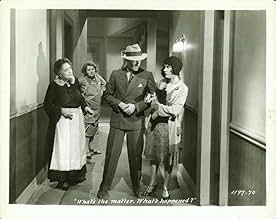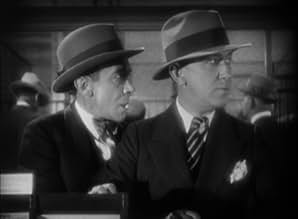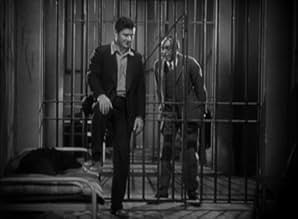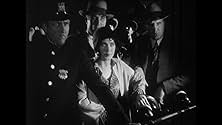Thunderbolt, big boss de Harlem, apprend que Ritzy veut le quitter pour un employé de banque. Pour s'en débarrasser elle le livre à la police. Même depuis le couloir de la mort de Sing-Sing,... Tout lireThunderbolt, big boss de Harlem, apprend que Ritzy veut le quitter pour un employé de banque. Pour s'en débarrasser elle le livre à la police. Même depuis le couloir de la mort de Sing-Sing, Thunderbolt cherchera à éliminer son rival.Thunderbolt, big boss de Harlem, apprend que Ritzy veut le quitter pour un employé de banque. Pour s'en débarrasser elle le livre à la police. Même depuis le couloir de la mort de Sing-Sing, Thunderbolt cherchera à éliminer son rival.
- Réalisation
- Scénario
- Casting principal
- Nommé pour 1 Oscar
- 2 victoires et 1 nomination au total
Ernie Adams
- Thug in Bank at Robbery
- (non crédité)
Elmer Ballard
- Prisoner #8
- (non crédité)
Louise Beavers
- Black Cat Cafe Patron
- (non crédité)
Ed Brady
- Chuck - 1st Prisoner #5
- (non crédité)
Avis à la une
If you can get past the really rather stilted production here - almost stage bound in it's presentation, this is quite an entertaining film that sees the authorities on the trail of the most wanted "Thunderbolt" (George Bancroft). He is elusive, though - and their only route to him might be through his ex-girfriend "Ritzie" (Fay Wray) - but she isn't playing ball for reasons of her own. It's only when "Thunderbolt" makes good on an earlier threat he made to her about seeing anyone else, that the police see some light. The performances are fine, not great but the writing is really quite good - plenty of quirky vernacular and it moves along well despite the frequent silent movie style direction and scene framing from Josef von Sternberg. There is also quite an enjoyable contribution from a blues ensemble and though certainly dated, this is still worth a watch almost 100 years later.
In 1929, talking pictures were still a novelty and some pictures in Hollywood were still coming out silent. So, it's not very surprising that this Josef von Sternberg movie comes off as a bit old fashioned. It's lack of incidental music* makes it seem a bit too quiet...but that was true of all the sound films of the day. Likewise, some of the acting is a bit stilted...and this was not at all unusual for 1929. So, I try to cut this and other movies from 1927-30 a bit of slack.
The title character, Thunderbolt Jim Lang (George Bancroft), is one of the most-wanted men in the country. He's been responsible for many bank robberies and deaths and the police are desperately searching for him. But their only lead is his old girlfriend, Ritzie (IMDB incorrectly spells it 'Ritzy' and she's played by Fay Wray). But she's sick of him and wants to go straight--and has taken up with a nice guy, Bob (Richard Arlen). But Thunderbolt has promised that if she takes up with ANYONE other than him, he'll get them...and he does this in a most peculiar way...while he's in prison! Huh? How does he do this and how does it all end? See the film and find out for yourself.
The film has some very good things going for it--particularly the mobster talk throughout the movie. It's all very tough and fun. Bancroft's performance is also quite entertaining (not necessarily GOOD but entertaining). Still, the movie's plot is very tough to believe though it is still entertaining to see today...even with its old fashioned style and bizarre scenes with Thunderbolt inexplicably in his cell with a pet dog!
*Instead of the usual background music, it's a quiet film--normal for 1929. But in all the death row scenes, there is often some sort of spiritual being sung...and wow were they annoying and overdone!
The title character, Thunderbolt Jim Lang (George Bancroft), is one of the most-wanted men in the country. He's been responsible for many bank robberies and deaths and the police are desperately searching for him. But their only lead is his old girlfriend, Ritzie (IMDB incorrectly spells it 'Ritzy' and she's played by Fay Wray). But she's sick of him and wants to go straight--and has taken up with a nice guy, Bob (Richard Arlen). But Thunderbolt has promised that if she takes up with ANYONE other than him, he'll get them...and he does this in a most peculiar way...while he's in prison! Huh? How does he do this and how does it all end? See the film and find out for yourself.
The film has some very good things going for it--particularly the mobster talk throughout the movie. It's all very tough and fun. Bancroft's performance is also quite entertaining (not necessarily GOOD but entertaining). Still, the movie's plot is very tough to believe though it is still entertaining to see today...even with its old fashioned style and bizarre scenes with Thunderbolt inexplicably in his cell with a pet dog!
*Instead of the usual background music, it's a quiet film--normal for 1929. But in all the death row scenes, there is often some sort of spiritual being sung...and wow were they annoying and overdone!
Sternberg's first Talkie is virtually a retread of his UNDERWORLD (1927), with the same leading man – George Bancroft – no less. However, while ably flanked by his co-stars there, he is practically the whole show this time around (Fay Wray and Richard Arlen being no match for Evelyn Brent and Clive Brook) and, consequently, the role earned Bancroft his sole Oscar nomination (and the film's as well)! Anyway, the director's approach to Sound was not as experimental as may have been anticipated (resorting to Death Row histrionics and even a number of songs to showcase the format!) and the end result is hardly dazzling in this regard – though the dialogue is surprisingly clean, i.e. audible, for such an early example. Conversely, the visual aspect of the film, usually the director's main concern, is greatly diluted here through the poor quality of the copy I watched which also sported forced German subtitles!
Bancroft is once again a gangster (as before, his activity remains undisclosed throughout, apart from lording it up in an almost exclusively-black nightclub!) and his moll eventually leaves him for another, younger and handsomer, man. Here, too, the mobster is caught and imprisoned – in a wonderful scene where he shows compassion for a mutt, subsequently proving inseparable, thus preceding Raoul Walsh's HIGH SIERRA by 12 years! Yet, he ingeniously has his associates frame the rival for a murder they committed (the development of this particular plot strand is unfortunately rather muddled) and the hero winds up in the cell opposite Bancroft's. As in UNDERWORLD, Fred Kohler also appears here to antagonize the latter – besides lanky warden Tully Marshall and an Irish guard whose name the protagonist continually tries to guess (with the droll pay-off coming at the film's very conclusion).
Wray and her mother plead with the gangster to do the right thing and clear Arlen of his crime but, of course, he will have none of that at the start. Again, however, Bancroft is softened and confesses his role in the young man's entrapment just hours before his execution is due; I have to wonder here why he, a first-time felon, is scheduled to die before the much sought-after "Thunderbolt"! – yes, the film's title is a reference to the character's nick-name. In any case, the moll's own admission that she had left her lover for the gangster rather than the other way around makes the latter realize, as was the case in UNDERWORLD, that he is in the way and gladly accepts his fate. Incidentally, speaking of references to the director's earlier work, Wray and Arlen are made to undergo a hasty marriage here – much like Bancroft himself and Betty Compson in THE DOCKS OF NEW YORK (1928)!
Bancroft is once again a gangster (as before, his activity remains undisclosed throughout, apart from lording it up in an almost exclusively-black nightclub!) and his moll eventually leaves him for another, younger and handsomer, man. Here, too, the mobster is caught and imprisoned – in a wonderful scene where he shows compassion for a mutt, subsequently proving inseparable, thus preceding Raoul Walsh's HIGH SIERRA by 12 years! Yet, he ingeniously has his associates frame the rival for a murder they committed (the development of this particular plot strand is unfortunately rather muddled) and the hero winds up in the cell opposite Bancroft's. As in UNDERWORLD, Fred Kohler also appears here to antagonize the latter – besides lanky warden Tully Marshall and an Irish guard whose name the protagonist continually tries to guess (with the droll pay-off coming at the film's very conclusion).
Wray and her mother plead with the gangster to do the right thing and clear Arlen of his crime but, of course, he will have none of that at the start. Again, however, Bancroft is softened and confesses his role in the young man's entrapment just hours before his execution is due; I have to wonder here why he, a first-time felon, is scheduled to die before the much sought-after "Thunderbolt"! – yes, the film's title is a reference to the character's nick-name. In any case, the moll's own admission that she had left her lover for the gangster rather than the other way around makes the latter realize, as was the case in UNDERWORLD, that he is in the way and gladly accepts his fate. Incidentally, speaking of references to the director's earlier work, Wray and Arlen are made to undergo a hasty marriage here – much like Bancroft himself and Betty Compson in THE DOCKS OF NEW YORK (1928)!
During the early days of talkies, dialogue writers were in great demand, and many who made the move to California were involved in the Broadway theater industry. The first regular theater critic for The New Yorker, Herman Mankiewicz, was soon in high demand in Hollywood after synchronized sound was introduced to cinema. A prime example of Mankiewicz's style was his screenplay in the early talkie, June 1929 "Thunderbolt." In 1927 Paramount Pictures hired Mankiewicz to write scenarios for its silent films. The studio asked him to work his connections for New York City writers to compose film scripts when talkies arrived. "Most of the newer writers on Paramount's staff who contributed the most successful stories of the past year (1929) were selected by 'Mank,'" wrote film critic Pauline Kael. Herman was the subject in the Netflix 2020 biopic, "Mank."
Mankiewicz's famous telegram to Ben Hecht describes how desperate movie studios were to hire good writers. "Millions are to be grabbed out here and your only competition is idiots. Don't let this get around."
Mankiewicz was the highest-paid writer in Tinseltown. Kael described, "His heroes weren't soft-eyed and bucolic; he brought good-humored toughness to the movies, and energy and astringency. And the public responded, because it was eager for modern American subjects." In "Thunderbolt," adapted from a Charles and Jules Furthman story, Mankiewicz's script focuses on Jim Lang (George Bancroft), nicknamed Thunderbolt, wanted by the police. His girlfriend, 'Ritzy' (Fay Wray), is seeing banker Bob Moran (Richard Arlen) behind Jim's back. Lang is captured and is headed for the chair. In jail, he discovers who Ritzy's boyfriend is and frames Bob in a cop's murder. When arrested and sentenced, Bob finds himself in the jail cell next to Thunderbolt.
"Thunderbolt" was the type of movie designed for director Josef von Sternberg for his first talkie. The silent movie director of 1927's "Underworld," which introduced the gangster genre, was excited to be making talkies. He said he was "no longer at the mercy of movie house organists."
Sternberg especially loved to mix music with his actors' dialogue. In a classic nightclub scene, singer actress Theresa Harris, in her film debut, belts out a song while Thunderbolt and Ritzy are in an argument. Between Harris' numbers, the jazz band plays in the background while tension builds between Lang and nearby loud customers. The tense sequence reveals the inner turmoil of Thunderbolt. Film critic Andrew Sarris notes, "'Thunderbolt' is, in some respects, as much a musical as a melodrama." Sternberg was praised overseas for his film, receiving a telegram from German director Ludwig Berger, stating "I saw your film 'Thunderbolt' and congratulate you with all my heart. It is the first fully realized and artistically accomplished sound film. Bravo!" "Thunderbolt" was the second talkie for actor George Bancroft, his first was the now lost 1929 'The Wolf of Wall Street.' The actor earned a Best Actor Academy Award nomination for his role as Thunderbolt.
The future was bright for Mankiewicz, working alongside his younger brother, Joseph, who wrote the titles in "Thunderbolt." Herman is known by today's movie fans as the first screenwriter for 1939's "The Wizard of Oz," and for his collaboration with Orson Welles in 1941's "Citizen Kane."
Mankiewicz's famous telegram to Ben Hecht describes how desperate movie studios were to hire good writers. "Millions are to be grabbed out here and your only competition is idiots. Don't let this get around."
Mankiewicz was the highest-paid writer in Tinseltown. Kael described, "His heroes weren't soft-eyed and bucolic; he brought good-humored toughness to the movies, and energy and astringency. And the public responded, because it was eager for modern American subjects." In "Thunderbolt," adapted from a Charles and Jules Furthman story, Mankiewicz's script focuses on Jim Lang (George Bancroft), nicknamed Thunderbolt, wanted by the police. His girlfriend, 'Ritzy' (Fay Wray), is seeing banker Bob Moran (Richard Arlen) behind Jim's back. Lang is captured and is headed for the chair. In jail, he discovers who Ritzy's boyfriend is and frames Bob in a cop's murder. When arrested and sentenced, Bob finds himself in the jail cell next to Thunderbolt.
"Thunderbolt" was the type of movie designed for director Josef von Sternberg for his first talkie. The silent movie director of 1927's "Underworld," which introduced the gangster genre, was excited to be making talkies. He said he was "no longer at the mercy of movie house organists."
Sternberg especially loved to mix music with his actors' dialogue. In a classic nightclub scene, singer actress Theresa Harris, in her film debut, belts out a song while Thunderbolt and Ritzy are in an argument. Between Harris' numbers, the jazz band plays in the background while tension builds between Lang and nearby loud customers. The tense sequence reveals the inner turmoil of Thunderbolt. Film critic Andrew Sarris notes, "'Thunderbolt' is, in some respects, as much a musical as a melodrama." Sternberg was praised overseas for his film, receiving a telegram from German director Ludwig Berger, stating "I saw your film 'Thunderbolt' and congratulate you with all my heart. It is the first fully realized and artistically accomplished sound film. Bravo!" "Thunderbolt" was the second talkie for actor George Bancroft, his first was the now lost 1929 'The Wolf of Wall Street.' The actor earned a Best Actor Academy Award nomination for his role as Thunderbolt.
The future was bright for Mankiewicz, working alongside his younger brother, Joseph, who wrote the titles in "Thunderbolt." Herman is known by today's movie fans as the first screenwriter for 1939's "The Wizard of Oz," and for his collaboration with Orson Welles in 1941's "Citizen Kane."
Nobody would argue that 1929 was a year of classic movies. Amongst the flotsam and jetsam however there's APPLAUSE and a few other good ones..... and this as well - almost. What a difference a top director and screenwriter can make!
This isn't a gangster film, it's an intelligently written character study and in-depth look into the mind of a mobster. You find writer Jules Furthman's name on virtually every other classic Hollywood picture of the 20s, 30s and 40s. His style was quality and his skill was creating believable engaging stories with real genuine characters. His story was further adapted by H Mankiewicz - who wrote the scripts for the probably the other half of the classics from this period. Needless to say - this is well written with fascinating and deeply faceted characters.
Josef von Sternberg directed this which by the look of it was his fiftieth talkie. Surely it's impossible that this was his first sound film? Being made in 1929, it's still a little experimental, not quite everything works so this is not one of his best pictures. Nevertheless he creates a brooding almost surreal atmosphere with real tension. That style intensifies significantly in the latter part of the film on death row which has an almost dream like feel about it.
The story is tense, the characters are believable, the production is innovative but this is not a perfect film. To enable clear sound recording, some but not all of the actors speak very slowly which sounds especially weird when the actor they're talking with is speaking normally. Actors had their own individual vocal coaches then with different techniques thus the inconsistency and maybe not being a native English speaker, von Sternberg probably didn't notice the subtle differences.
As great a director as he was, von Sternberg was given the impossible task of trying to make Fay Wray seem like a proper actress. Not even he could do that and predictably she's absolutely dreadful. As always she just projects that limp, whining and insipid expression to convey whatever emotion she's trying to express.
Whether she's pretending to be a hard as nails gangster's moll or a reformed, sweet and vulnerable fragile young thing she's that same bland, shallow character. Not only can't she act but in this she doesn't appear to be able to speak English - what on earth is that accent! She's meant to be a girl from the streets so why is she doing history's worst impression of Queen Mary? That two men could be besotted with this dull sour-faced non-entity completely stretches all credibility.
This isn't a gangster film, it's an intelligently written character study and in-depth look into the mind of a mobster. You find writer Jules Furthman's name on virtually every other classic Hollywood picture of the 20s, 30s and 40s. His style was quality and his skill was creating believable engaging stories with real genuine characters. His story was further adapted by H Mankiewicz - who wrote the scripts for the probably the other half of the classics from this period. Needless to say - this is well written with fascinating and deeply faceted characters.
Josef von Sternberg directed this which by the look of it was his fiftieth talkie. Surely it's impossible that this was his first sound film? Being made in 1929, it's still a little experimental, not quite everything works so this is not one of his best pictures. Nevertheless he creates a brooding almost surreal atmosphere with real tension. That style intensifies significantly in the latter part of the film on death row which has an almost dream like feel about it.
The story is tense, the characters are believable, the production is innovative but this is not a perfect film. To enable clear sound recording, some but not all of the actors speak very slowly which sounds especially weird when the actor they're talking with is speaking normally. Actors had their own individual vocal coaches then with different techniques thus the inconsistency and maybe not being a native English speaker, von Sternberg probably didn't notice the subtle differences.
As great a director as he was, von Sternberg was given the impossible task of trying to make Fay Wray seem like a proper actress. Not even he could do that and predictably she's absolutely dreadful. As always she just projects that limp, whining and insipid expression to convey whatever emotion she's trying to express.
Whether she's pretending to be a hard as nails gangster's moll or a reformed, sweet and vulnerable fragile young thing she's that same bland, shallow character. Not only can't she act but in this she doesn't appear to be able to speak English - what on earth is that accent! She's meant to be a girl from the streets so why is she doing history's worst impression of Queen Mary? That two men could be besotted with this dull sour-faced non-entity completely stretches all credibility.
Le saviez-vous
- AnecdotesOne of the earliest of over 700 Paramount productions, filmed between 1929 and 1949, which were sold to MCA/Universal in 1958 for television distribution, and have been owned and controlled by MCA ever since. However, because of its extreme age, and primitive sound recording techniques, there is no record of it ever having been locally televised. On cable TV it received what may have been its first and only telecast on Turner Classic Movies in August 2016.
- Versions alternativesMade in both sound and silent versions.
Meilleurs choix
Connectez-vous pour évaluer et suivre la liste de favoris afin de recevoir des recommandations personnalisées
- How long is Thunderbolt?Alimenté par Alexa
Détails
- Date de sortie
- Pays d’origine
- Langue
- Aussi connu sous le nom de
- L'assommeur
- Lieux de tournage
- Société de production
- Voir plus de crédits d'entreprise sur IMDbPro
- Durée1 heure 25 minutes
- Couleur
Contribuer à cette page
Suggérer une modification ou ajouter du contenu manquant


































